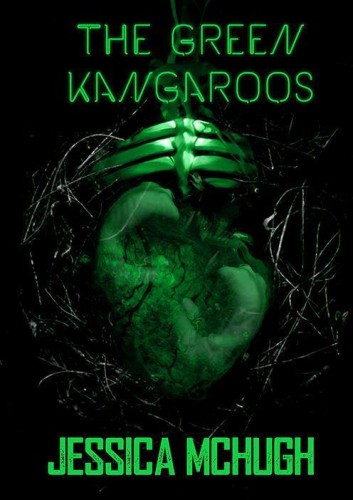 My first encounter with the writing of Jessica McHugh showed me an inventive horror short story called Food For Thought. Turns out, that’s just a tiny part of the McHughniverse. There’s also Pins, a suspenseful dark thriller involving strip clubs and bowling alleys. There’s the young adult mystery/thriller, Rabbits in the Garden. There’s her trip into the world of steampunk, The Maiden Voyage. And in August, she’ll be dropping a sci-fi mind-melting experience of Philip K. Dick proportions, The Green Kangaroos. Be prepared.
My first encounter with the writing of Jessica McHugh showed me an inventive horror short story called Food For Thought. Turns out, that’s just a tiny part of the McHughniverse. There’s also Pins, a suspenseful dark thriller involving strip clubs and bowling alleys. There’s the young adult mystery/thriller, Rabbits in the Garden. There’s her trip into the world of steampunk, The Maiden Voyage. And in August, she’ll be dropping a sci-fi mind-melting experience of Philip K. Dick proportions, The Green Kangaroos. Be prepared.
From the very first pages, you can already tell this might just be one of those experiences. You know the ones I mean, the ones where you feel like you need a good hot shower afterwards to clean the filth away. Right from the start, you find yourself thrown into the life of a down and out junkie named Perry Samson. He’s addicted to a drug called atlys, and from the first sentence of the first chapter, you know exactly how he prefers it: injected straight into the testicles. Yep, that is how The Green Kangaroos starts, in your face and nasty. And so it goes, as we go on a first person journey with Perry as he tries to score another hit, spies on his ex-wife, and contemplates “potsticking,” a new procedure where people sell chunks of flesh in exchange for drugs, flesh that is later eaten as a delicacy by the rich and powerful. The world McHugh creates is dirty, stinky, and vile, and we can’t wait to escape it.
How we might find this escape, however, is a whole other issue. Because by about the fourth chapter, we realize we aren’t completely sure of what is real and what is in “our” heads. We go from seeing the world through the eyes of Perry to watching from afar, as it turns out our protagonist is a new patient at the Sunny Daye Institute, a drug rehabilitation facility that boasts a 100% success rate. With a special virtual reality program, and with the help of the patient’s loved ones, they are able to put the addict through a series of “tests” in order to help get them off the bad stuff. The facility is run by Doctors Alan and Marla Daye, head scientist Doctor Jeremiah Carter, who also created the Institute, and Emily, an operating system that appears on the computer monitors throughout the complex and also appears to have human emotions. But how would what is essentially a robot have feelings? Hmmm…
The Green Kangaroos is a real head trip as we go back and forth from the virtual world in which Perry doesn’t seem to be getting any better, often putting drugs in front of family and friends, and then back into the real world, where things are also not quite what they first seemed. Is it possible that the Institute could really cure 100% of its patients? It seems unrealistic, but if not, what happens to the “failures?” We soon learn the truth, and it just makes our experience that much more horrifying. It all results in one of those “if I say too much, I might give away more than I intend to” situations, so I highly recommend you take the journey for yourself. It’s a wild one, and it’s well worth it.
Jessica McHugh manages to create a world that resembles our own just enough to give a false sense of security while at the same time reminding us of some of our worst nightmares (memories enabled by the dark, creepy cover art by George C. Cotronis). As I mentioned before, it has a definite Philip K. Dick feel to it, but is entirely an original creation. And while it deals with fictionalized horrors, such as the potsticking, it also deals with addiction in a very real way. Sure, the extremes Perry and others go to aren’t real (not yet, anyway), but they are symbolic of the all too real daily struggles of an addict. The giving up, the feeling of victimization, the loss of reality (in this book, something that seems to happen regularly), the re-prioritizing based on perceived needs and wants versus real needs. And in the end, after all is said and done, we find ourselves face to face with similar ethical struggles as we had with the Ludovico treatment in Burgess’s A Clockwork Orange – is the “patient” truly cured, or did we just convince ourselves that they were in order to feel better ourselves?
 Horror News | HNN Official Site | Horror Movies,Trailers, Reviews
Horror News | HNN Official Site | Horror Movies,Trailers, Reviews


Do you mind if I quote a few of your posts as long as I provide credit and
sources back to your site? My website is in the exact same niche as yours and my visitors would certainly benefit from
some of the information you provide here. Please let me
know if this okay with you. Thank you!
yes thats fine